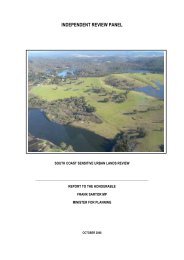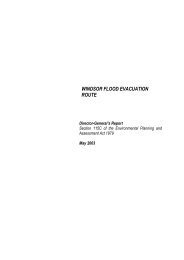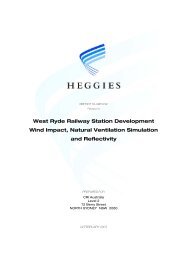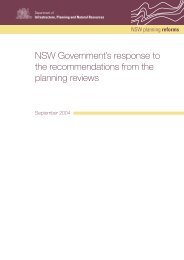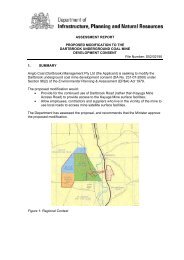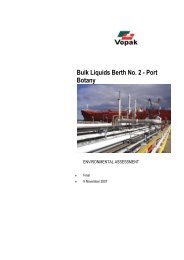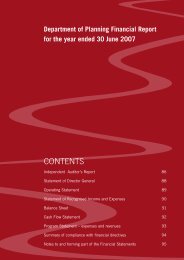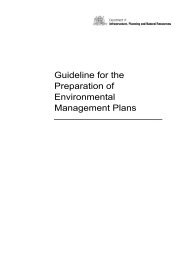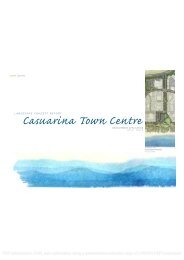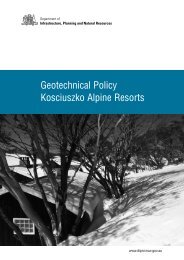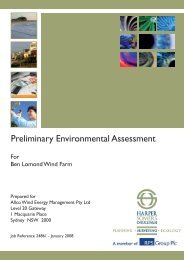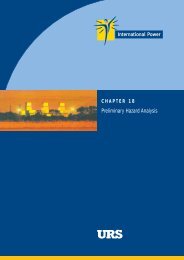Appendix P Drainage, Flooding, Stormwater Management Part 5
Appendix P Drainage, Flooding, Stormwater Management Part 5
Appendix P Drainage, Flooding, Stormwater Management Part 5
You also want an ePaper? Increase the reach of your titles
YUMPU automatically turns print PDFs into web optimized ePapers that Google loves.
<strong>Flooding</strong>, <strong>Drainage</strong> and <strong>Stormwater</strong> <strong>Management</strong><br />
Sanctuary Villages<br />
Details of XP-RAFTS developed model catchment data are summarised in <strong>Appendix</strong> B.<br />
Node locations used in the XP-RAFTS developed model are identical to those for the<br />
existing model and are shown in Figure 3.<br />
The percentage of impervious area for the development site has been adopted as 60%.<br />
This value has been adopted to represent the relative contribution of various land types<br />
including; road reserves, commercial, residential and parkland. This assumption is valid<br />
for a regional level study but a more detailed breakdown of land use will be considered at<br />
the local strategy level.<br />
3.2.3 Developed peak discharges<br />
Predicted developed flow rates within Congewai Creek at Millfield Bridge for the 1, 5, 10,<br />
20, 50 and 100 year ARI storm events are summarised in Table 3-4. Also shown are<br />
existing peak flow rates at this location and the percentage change in flow resulting from<br />
development. Runoff hydrographs for the critical duration storm that produced the largest<br />
peak flow estimate are provided in <strong>Appendix</strong> E for developed conditions. The critical<br />
storm duration that produced the peak flow rate at node CON.15 was the 720 minute<br />
storm for the 1 year ARI event and 2160 minute storm for all other events.<br />
Table 3-4: Developed peak flow estimates within Congewai Creek at Millfield Bridge (Node<br />
CON.15)<br />
ARI<br />
Existing Peak Flow<br />
Rate (m 3 /s)<br />
Developed Peak<br />
Flow Rate (m 3 /s)<br />
Percentage Change<br />
1 Year 62 62 0%<br />
5 Year 221 221 0%<br />
10 Year 296 295 -0.3%<br />
20 Year 392 391 -0.2%<br />
50 Year 571 571 0%<br />
100 Year 762 761 -0.1%<br />
Table 3-4 illustrates that the proposed development results in a negligible change in the<br />
critical duration peak flow rate at Millfield Bridge for the 1, 5, 10, 20, 50 and 100 year ARI<br />
storm events.<br />
Examination of Figure 3 shows the proposed development area to be located near the<br />
outlet of the analysed catchment, which extends as far as Millfield Bridge. The<br />
introduction of impervious surfaces at this location increases the rate of runoff from the<br />
lower portions of the catchment allowing runoff to enter Congewai Creek before the<br />
overall catchment flood peak. This is further supported by examination of the developed<br />
runoff hydrograph for the 1 year critical duration storm event contained within <strong>Appendix</strong><br />
E, which shows a small spike on the rising limb of the hydrograph when compared to the<br />
existing runoff hydrograph at this location.<br />
A comparison of existing and developed peak flow rates for the 1, 10 and 100 ARI storm<br />
events run for a range of storm durations is shown in Figure 5. Examination of Figure 5<br />
reveals negligible change in peak flow rate for the 10 and 100 year ARI storm events at<br />
Millfield Bridge for all storm durations. However, there is a minor increase in peak flow<br />
rate for the shorter duration 1 year ARI storm events. This increase in flow rate will<br />
require detention storage to reduce the potential for scour of existing drainage lines.<br />
PARSONS BRINCKERHOFF 2122870A-PR0116 Page 13



